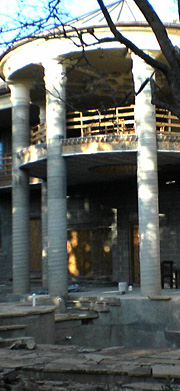Shells of Monster Homes Remind Oaxaca of Those Who Don't Return
 Katherine Corcoran - San Jose Mercury News Katherine Corcoran - San Jose Mercury News


| | Monster-home shells can be found all over the Oaxacan countryside amid some of Mexico's most dire poverty. |
Oaxaca, Mexico - It's known as la casa blanca - the White House - an American-style McMansion with a portico modeled after its U.S. namesake.

The extravagant curiosity juts like a tiered wedding cake above a pig pen and single-story concrete box more typical of the farmhouses in this rural pueblo of 3,600 people 10 miles west of the city of Oaxaca. What's more, it's half-finished and empty, with wild grass growing in the cracks of the neglected porch.

Such monster-home shells can be found all over the Oaxacan countryside amid some of Mexico's most dire poverty. They're the projects of immigrants who left for the United States and send money back to build their dream homes under the supervision of parents or other family members.

In prospering pueblos such as San Pablo Huixtepec, about 22 miles south of here, such houses hold the families and success stories of immigrants abroad. But here and in other parts of Oaxaca, Mexico's second-poorest state to Chiapas, they become known as "casas abandonadas" - where idled construction is a stark symbol of the countless people who never return.

"They're very common," said Beltran Arenas Velazco, former employee of the Instituto Oaxaqueno de Atencion al Migrante, a state agency in downtown Oaxaca that assists people who have emigrated. "They're beautiful places where no one lives, or the families use them to store corn or beans. The sons don't want to come back."

Gerardo Perez Ruiz says the White House is not abandoned.

It belongs to his son, Raul, 27, who quit his accounting studies seven years ago to go north and now works 15-hour days in a restaurant in Phoenix. He started the White House three years ago, sending photos and drawings of the one in Washington, D.C., for the design.

"`It's the most beautiful building in all the world,'" Perez says, quoting his son, adding, "It's a symbol of his success in the United States and his hard work, but also of his sacrifice and all he wants to do for his pueblo here."

Construction stopped a year ago, when his son started paying medical bills for his girlfriend, who has kidney problems, Perez says. He still hopes to finish it and return home to start a water purification company. More than 25 percent of the population in the state of Oaxaca lacks access to drinking water.

Meanwhile, Perez and his wife, Josefina, who live next door in a modest one-story home with an outdoor lavatory, have no desire to occupy the palatial property.

"We all have our own houses," Perez says, finding the question odd.

In the neighboring pueblo of San Andres Ixtlahuaca, Roman Hernandez Morales watches over the property next door - a brick shell with empty windows. It belongs to his son, Eugenio Hernandez Hernandez, 47, who works on a farm in Guadalupe, Calif. The son started building the house eight years ago, but has stopped for now to finance another American Dream - putting his two children, ages 21 and 20, through college.

In the same village, Valentina Maria Cortez Miranda no longer has the key to her brother Enrique's two-story house next door, which is overrun with vegetation. He started construction about 18 years ago. She can't remember, and after breaking in through a hole in the fence "like a rabbit," she sweeps the debris-ridden concrete stair in search of a date. There is a horse-drawn cart stored in the breezeway and bags of dry concrete in what would have been the kitchen.

She no longer even knows where her brother is living. He used to return every three years to work on the house, but stopped. She picks up some avocados that have fallen from a tree into the overgrowth and makes her way back through the fence to her concrete hut with one door and one window.

"I wouldn't know what to tell you," she says. |



